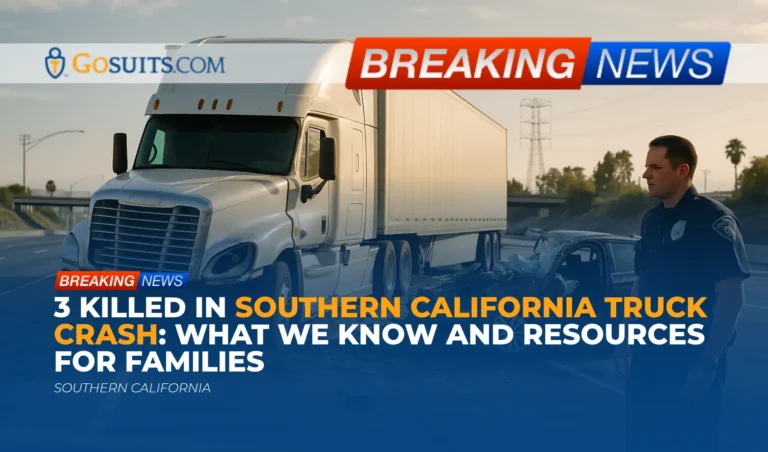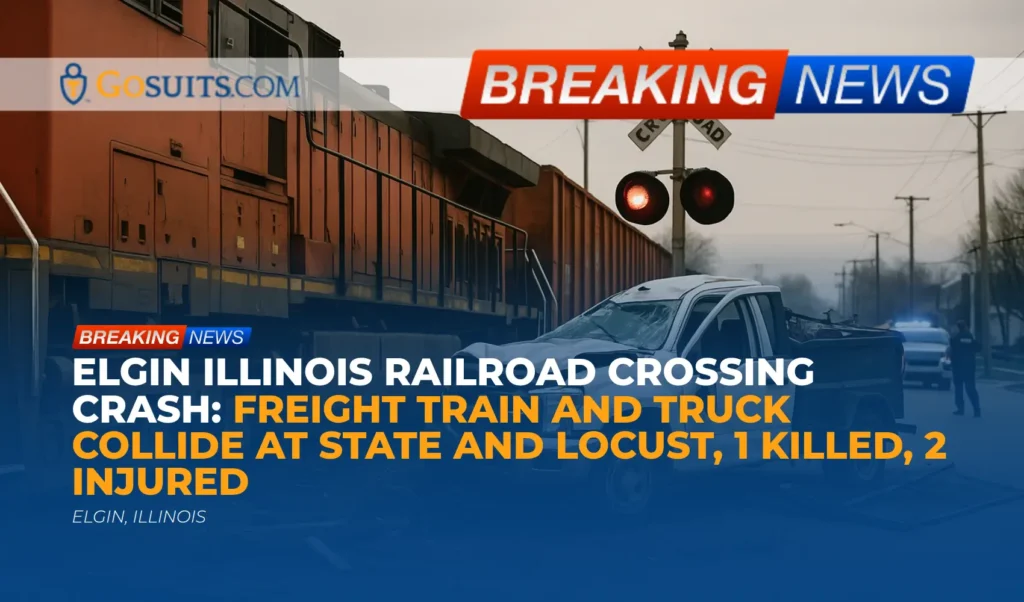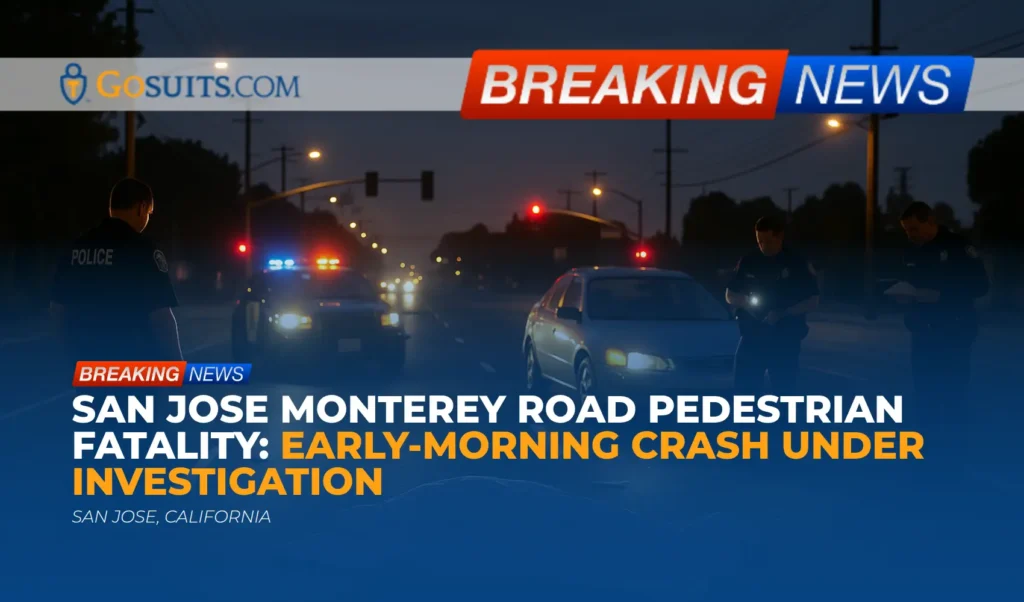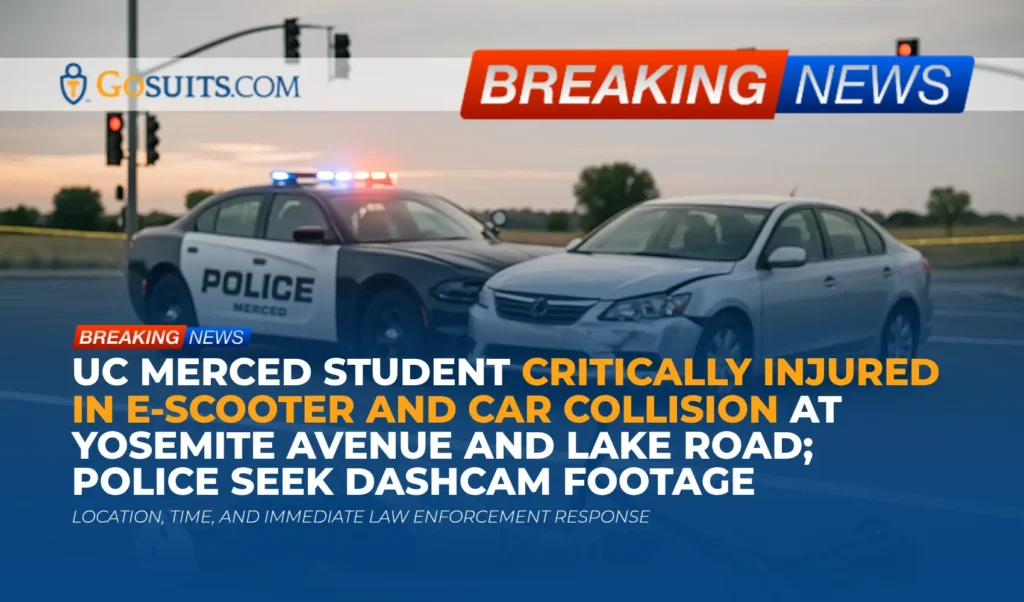- What we know about the Southern California crash
- Why truck crashes can be so deadly: data and context
- Key legal considerations after a fatal truck crash in California
- Immigration status and civil justice in California
- Who may be liable in a multi-fatality truck crash
- Immediate steps families often take to get official records and support
- Preserving evidence from the trucking company
- Insurance issues that arise in fatal truck collisions
- Wrongful death and survival claims in California: timelines and eligibility
- How investigations typically proceed and how long they take
- Grief, victim services, and credible public resources
- Commentary from Gosuits Southern California Personal Injury Attorney
- Action steps that cannot wait
What we know about the Southern California crash
Authorities have confirmed a fatal collision in Southern California that involved a truck driver described as undocumented. The crash occurred on a Tuesday and resulted in three fatalities. Reporting indicates the incident drew the attention of federal Homeland Security officials. As of this writing, there is no additional verified public information about the precise location, roadway, the trucking company involved, the type of cargo, or the sequence of events leading to the collision. No names have been released in the information provided.
When multiple lives are lost, it is common for several agencies to become involved in parallel: local or state law enforcement for the traffic investigation, county medical examiners to determine cause and manner of death, and sometimes federal transportation safety officials for broader safety reviews. In situations where immigration status is mentioned publicly, it is important to separate that issue from the civil investigation into fault and from the rights of those harmed to seek civil remedies.
Why truck crashes can be so deadly: data and context
Crashes involving large commercial trucks are more likely to cause severe outcomes because of the size and weight of these vehicles, the stopping distances required, and the forces involved when a tractor-trailer collides with a passenger car. Nationally, crashes involving at least one large truck account for thousands of fatalities each year. The National Highway Traffic Safety Administration publishes annual summaries showing the human toll and the risk factors that contribute to serious outcomes for occupants of other vehicles, pedestrians, and cyclists. For current traffic safety facts on large trucks, see NHTSA’s resources at nhtsa.gov.
Common risk factors identified in truck-involved fatal crashes include high speed relative to conditions, inadequate following distance, fatigue and hours-of-service violations, improper cargo securement or overloading, equipment failures like worn brakes or tires, lane departure, and impaired or distracted driving. The Federal Motor Carrier Safety Administration oversees rules designed to reduce these risks, including hours-of-service limits and vehicle maintenance requirements. Summaries of the hours-of-service rules are available through FMCSA at fmcsa.dot.gov.
Key legal considerations after a fatal truck crash in California
In California, a civil case following a fatal traffic collision typically examines whether any person or company failed to use reasonable care and whether that failure caused the deaths or injuries. In the context of a commercial truck, the analysis often focuses on the conduct of the driver and the motor carrier’s safety practices. It may also extend to companies that loaded the cargo, serviced the vehicle, or coordinated transportation.
Some foundational points in truck collision matters include the following:
- Duty of care on the road. All drivers owe a duty to operate safely and in compliance with the California Vehicle Code. Commercial drivers also must follow federal safety regulations that apply to hours of service, recordkeeping, maintenance, and inspections. FMCSA guidance on hours of service and related recordkeeping can be found at fmcsa.dot.gov.
- Employer responsibility. When the driver is acting within the course and scope of employment, the motor carrier can be responsible for the driver’s negligence. This is often called vicarious liability. Separate theories may apply if the company itself had unsafe policies, failed to train or supervise adequately, or allowed an unfit vehicle on the road.
- Regulatory compliance and evidence. Trucking companies must keep certain safety and maintenance records for defined periods. For example, hours-of-service records are generally retained for six months, and vehicle maintenance files have specific retention periods. See FMCSA rules and explanations at fmcsa.dot.gov. Prompt action to request that relevant records be preserved is important because routine retention periods are limited.
- Insurance requirements. Interstate motor carriers hauling non-hazardous property are required to carry minimum liability limits under federal law. Minimum limits are outlined in 49 CFR 387.9, viewable at the Electronic Code of Federal Regulations on ecfr.gov. Many carriers carry higher limits, and additional coverage may exist through excess policies, shippers, or brokers.
Immigration status and civil justice in California
California law is clear that immigration status must not be used to deter or diminish civil claims for personal injury or wrongful death. Evidence Code section 351.2 provides that immigration status is generally inadmissible in civil actions for personal injury or wrongful death, except in very limited circumstances to comply with federal law. The statute is published by the California Legislature at leginfo.legislature.ca.gov.
In plain terms, whether a driver is undocumented, a citizen, or holds another status does not change whether a negligent act occurred or whether a family may pursue a civil claim for losses. Civil fault is determined by conduct and causation, not by status.
Who may be liable in a multi-fatality truck crash
Each catastrophic collision is unique, and liability can be complex. While the specifics of this Southern California crash have not been released, investigations commonly assess potential responsibility along these lines:
- The truck driver. Did the driver follow traffic laws, maintain safe speed and following distance, avoid distraction, and comply with hours-of-service rules designed to prevent fatigue.
- The motor carrier or employer. Did the company vet the driver appropriately, conduct required drug and alcohol testing, maintain accurate hours-of-service records, and ensure the vehicle was inspected, repaired, and maintained per federal standards. See general maintenance responsibilities at FMCSA’s site fmcsa.dot.gov.
- Vehicle owner or maintenance provider. If maintenance was outsourced, was the work performed competently and documented.
- Cargo loader or shipper. Was the load within legal weight limits and properly secured to prevent shifting that can destabilize the truck.
- Other motorists or conditions. Investigations consider the actions of all motorists involved, as well as roadway design, signage, and visibility. Public entities may be evaluated if an unsafe road condition contributed, though these claims follow special rules.
It is not uncommon for multiple insurers to be involved. Identifying every potentially responsible party early helps ensure that critical evidence is preserved and that all available insurance coverage is considered.
Immediate steps families often take to get official records and support
Official records help answer what happened and are often needed for estate and insurance matters. Although agencies vary by county and city, the following California resources are frequently relevant in Southern California.
Collision reports
If the California Highway Patrol investigated, collision reports are requested through CHP area offices. Information about requesting a report and the CHP 190 form appears on the CHP website at chp.ca.gov. If a city police department or a county sheriff’s office took the report, requests typically go through that agency’s records division.
Medical examiner and autopsy records
In fatal cases, county medical examiner or coroner offices determine cause and manner of death. Each county has its own procedures for releasing reports and confirming next of kin. For Southern California, these offices provide public guidance:
- Los Angeles County Medical Examiner: Information on reports and decedent affairs is available at me.lacounty.gov.
- San Diego County Medical Examiner: Policies and request instructions are at sandiegocounty.gov.
- San Bernardino County Sheriff-Coroner: Coroner information can be found at sbcounty.gov.
For counties not listed here, the county’s official .gov website typically provides the Medical Examiner or Coroner page with phone numbers, hours, and records request instructions.
Death certificates
Certified death certificates in California are issued by county vital records offices or the California Department of Public Health. The state provides instructions at cdph.ca.gov.

Victim assistance
California’s Victim Compensation Board offers help with certain costs for eligible victims and family members, such as funeral expenses and mental health counseling. Information is available at victims.ca.gov.
Preserving evidence from the trucking company
Critical evidence in truck cases can be lost quickly through routine business practices unless preservation is requested in writing. Time-sensitive materials include: electronic control module or event data recorder downloads, dash camera footage, telematics and GPS logs, bills of lading and dispatch records, driver qualification and training files, hours-of-service logs and supporting documents, drug and alcohol testing results if applicable, maintenance and inspection records, and post-crash vehicle inspections.
Federal regulations require motor carriers to keep certain records for defined periods, but those periods can be short. Hours-of-service supporting documents, for example, are generally kept for six months. Vehicle inspection, repair, and maintenance files have retention requirements while the vehicle is in service and a limited period after. See FMCSA regulations and guidance at fmcsa.dot.gov. Sending a prompt written preservation request can help ensure these materials are not overwritten or discarded.
Insurance issues that arise in fatal truck collisions
Commercial truck crashes can involve multiple layers of insurance, including the driver’s employer’s primary liability policy, excess or umbrella policies, trailer or equipment owner coverage, and potentially policies held by shippers or brokers depending on the relationships involved. Federal regulations set minimum liability insurance limits for interstate carriers transporting property, with minimums described in 49 CFR 387.9 at ecfr.gov.
Insurance companies open investigations early and often request recorded statements. People sometimes do not realize that statements made to an insurance adjuster can be used later to dispute or minimize claims. Before contacting any insurer, it is prudent to speak with a qualified attorney in order to understand rights and obligations. Communications with insurers should be carefully considered, particularly when multiple policies and competing interests are involved.
Wrongful death and survival claims in California: timelines and eligibility
California law allows certain family members to bring wrongful death claims and permits a separate claim, called a survival action, for losses incurred by the decedent before death. The California Courts’ self-help center provides a helpful overview of who may file and how these claims work at courts.ca.gov.
Key timing considerations include:
- General time limit. Wrongful death lawsuits in California usually must be filed within two years from the date of death. There are exceptions that can shorten or extend deadlines in specific circumstances, so checking the particular facts against the law is important.
- Claims involving public entities. If a potential claim involves a public entity, such as an unsafe roadway maintained by a government agency, a government claim often must be filed within six months. See the California Government Claims Program information at dgs.ca.gov.
Because limitations periods are strict, timely attention to potential claims helps protect the ability to seek civil remedies.
How investigations typically proceed and how long they take
After a fatal crash, law enforcement typically documents the scene with measurements, photographs, and witness interviews. Vehicles may undergo mechanical inspections. In serious cases, reconstruction specialists model speeds, angles, and braking to understand causation. Medical examiners determine causes of death. Depending on complexity, official traffic collision reports may take several weeks to several months to finalize.
In some crashes with significant public safety implications, state and federal agencies may participate in specialized investigations. While the National Transportation Safety Board does not investigate every highway crash, it sometimes investigates high-profile or particularly complex events. General information on NTSB investigations is available at ntsb.gov.
Parallel civil investigations often begin sooner, focusing on preserving electronic data and physical evidence, identifying witnesses, and securing third-party records such as 911 audio and traffic camera footage. The earlier this work begins, the less likely it is that transient evidence will be lost.
Grief, victim services, and credible public resources
Sudden loss is devastating. For families coping with bereavement after a fatal collision, practical tasks like obtaining records and handling logistics can feel overwhelming. California’s public resources can provide information and limited assistance:
- Victim compensation. The California Victim Compensation Board offers programs that may help with funeral and burial expenses, mental health counseling, and other verified costs. Program details are at victims.ca.gov.
- County medical examiner support. County medical examiner or coroner offices typically have staff who guide families through next steps, timelines, and release of remains. See the relevant county’s official .gov site, such as me.lacounty.gov for Los Angeles County or sandiegocounty.gov for San Diego County.
- State traffic safety information. The California Office of Traffic Safety and NHTSA provide educational materials on roadway safety trends and prevention strategies at nhtsa.gov.
Support from community, faith groups, and licensed counselors can also be an important part of healing. Public programs are not a substitute for personal support networks and informed legal guidance, but they can help address immediate needs.
Commentary from Gosuits Southern California Personal Injury Attorney
Our hearts go out to everyone affected by this tragic crash in Southern California. Losing three lives in a single incident brings immeasurable grief to families and friends, and it impacts the wider community that shares these roads. This commentary is offered for educational purposes and general information so that community members can better understand the civil issues that often arise after a fatal truck collision.
Although details are limited, the mention of a commercial truck and multiple fatalities points to questions that deserve careful answers: Was the vehicle properly maintained and loaded. Were hours-of-service rules followed to reduce the risk of fatigue. Was speed appropriate for traffic and conditions. Did any company policy or oversight failure contribute. These are the kinds of questions civil investigations ask, because truck operations are complex and evidence is often distributed across many hands.
It is also important to be clear about immigration status. In California civil courts, immigration status does not determine whether someone is accountable for negligence nor whether a grieving family can seek civil remedies. The focus is on conduct, causation, and the harm suffered.
Insurance companies and large corporations move quickly after serious crashes. Adjusters and corporate investigators are trained to manage risk for their insureds. Common tactics include requesting recorded statements early, narrowing the scope of requested documents, and shaping narratives before all facts are known. Without a full understanding of the applicable rules and the potential layers of insurance, people can feel pressured to accept early decisions that do not reflect the full harms and losses.
A free consultation with a seasoned injury attorney can help clarify rights, identify urgent preservation needs, and provide guidance on how to handle insurer communications. It is often wise to seek that consultation before speaking with any insurance adjuster. Statements made to insurers can be used later and may affect how claims are evaluated. Understanding the roadmap early can reduce confusion and help preserve the truth of what happened.

Action steps that cannot wait
When a catastrophic truck crash occurs, timing can shape outcomes. The following actions are time-sensitive and often make a meaningful difference in protecting the record of what happened and in navigating practical needs:
- Obtain official records. Request the traffic collision report from the investigating agency as soon as it is available. If CHP investigated, see the process at the California Highway Patrol’s collision reports page on chp.ca.gov. Follow up with the county medical examiner or coroner for autopsy findings and cause and manner of death once those are finalized.
- Preserve evidence immediately. Send written preservation requests to involved companies for vehicle data, dash camera footage, telematics, hours-of-service records, driver qualification files, maintenance files, and cargo documents. Some of these records are routinely deleted after short retention periods.
- Document everything. Keep a log of contacts with insurers, law enforcement, and medical examiner staff. Save receipts, funeral and memorial expenses, and communications that may be relevant later.
- Coordinate estate and benefits paperwork. Begin the process of obtaining certified death certificates through county vital records or the California Department of Public Health at cdph.ca.gov. This documentation is often required for insurance, banking, and benefits matters.
- Approach insurance communications with care. Before any recorded statement or detailed discussion with insurers, consult a qualified attorney for a free case review to understand rights and responsibilities. Statements to adjusters can be used later and may shape claim evaluations.
- Track deadlines. Be mindful of civil time limits. In California, wrongful death lawsuits generally must be filed within two years, and some claims against public entities require a government claim within six months. See the California Courts’ overview at courts.ca.gov and the Government Claims Program at dgs.ca.gov.
- Seek supportive services. Explore eligibility for victim compensation assistance at victims.ca.gov, and consider counseling resources to help cope with grief.
Additional reliable resources
- NHTSA Traffic Safety Data: nhtsa.gov
- FMCSA Safety Regulations: fmcsa.dot.gov
- Hours-of-Service Rules: fmcsa.dot.gov
- Minimum Trucking Insurance Limits: ecfr.gov
- California Evidence Code § 351.2: leginfo.legislature.ca.gov
- California Wrongful Death Overview: courts.ca.gov
- California Government Claims Program: dgs.ca.gov
- California Highway Patrol Collision Reports: chp.ca.gov
- Los Angeles County Medical Examiner: me.lacounty.gov
- San Diego County Medical Examiner: sandiegocounty.gov
- San Bernardino County Sheriff-Coroner: sbcounty.gov
- California Department of Public Health Vital Records: cdph.ca.gov






